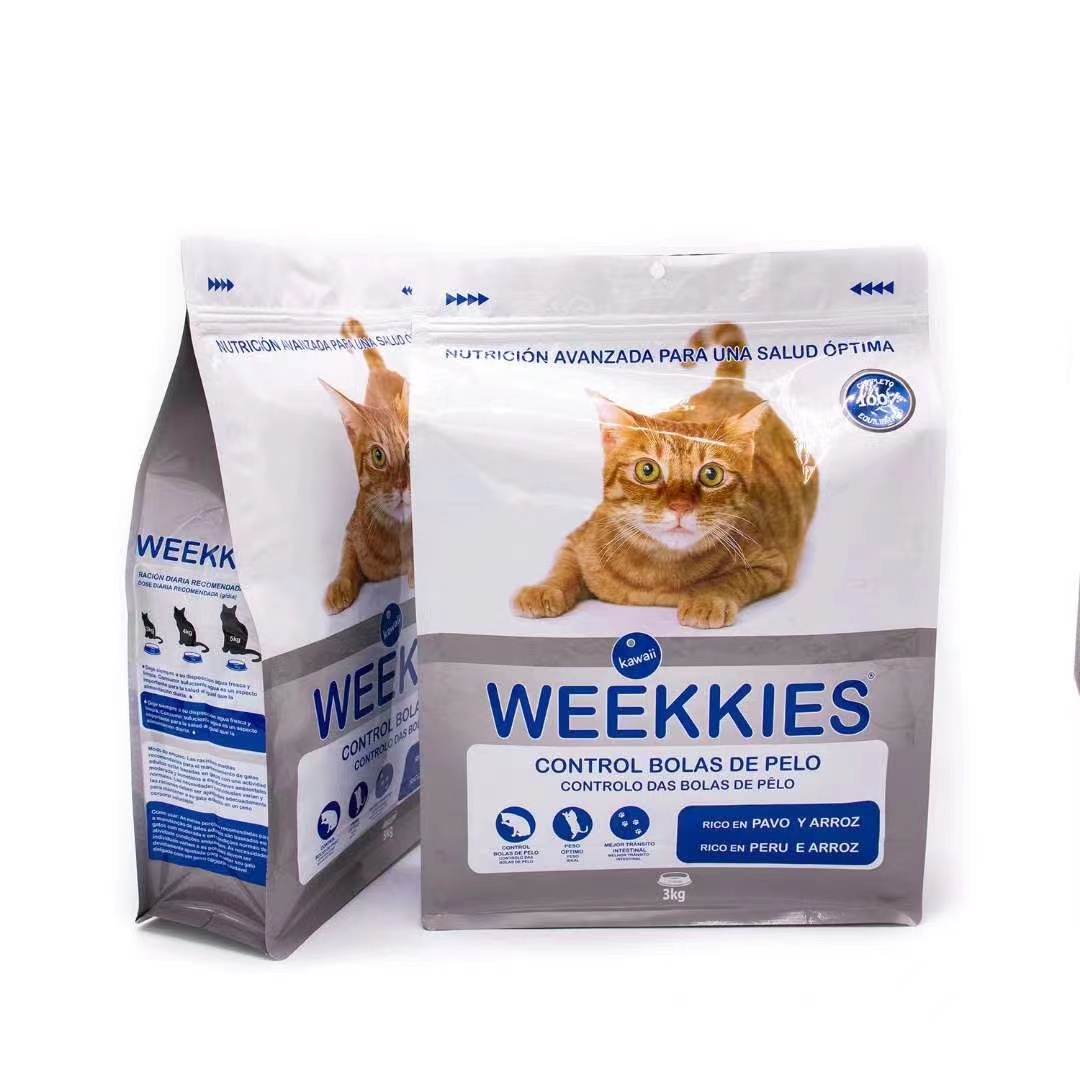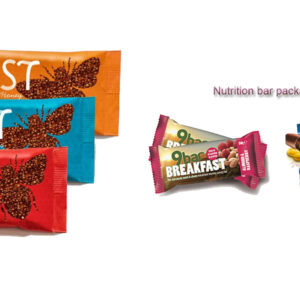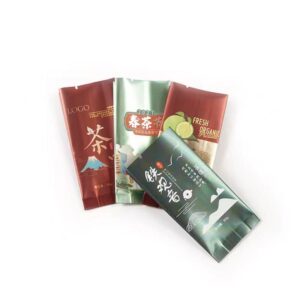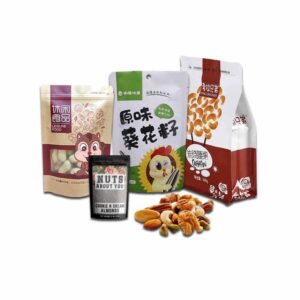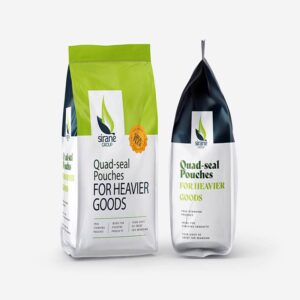Pet food bag
pet food bags offer convenience, freshness, portion control, variety, and safety, making them an essential item for pet owners who want to provide their pets with high-quality food.
Additional information
| color | custom |
|---|---|
| size | 2lb, 5lb, 10lb, 15lb, 20lb, 25lb etc. |
| description | custom pet food bag with multi-material |
| valve | no degassing valve |
| stock | NO |
Product details
Pet is the best friends of human. The Pet food is so much important to them. So people pay more attention on that.
How can I choose the pet food packaging bag?
When choosing pet food packaging bags, there are several factors to consider, including:
- Material: The material of the bag is crucial to consider. The most common materials used for pet food packaging bags are paper, plastic, and a combination of both. Plastic bags are more durable and moisture-resistant, while paper bags are more eco-friendly and biodegradable. A combination of both can offer the best of both worlds.
- Size: You'll need to choose a bag size that suits your pet food quantity. Consider the amount of food your pet consumes, as well as the size of the kibble or treats.
- Closure: The type of closure on the bag is also essential to consider. Some bags have zip-lock closures, while others have tape or adhesive closures. Consider which closure method will keep the food fresh and secure the longest.
- Durability: You'll want to choose a bag that's durable enough to withstand transportation and storage. Look for bags with thicker material, strong seams, and handles for easy carrying.
- Branding: If you're selling your own pet food, you'll want to choose a packaging bag that reflects your brand's image. You can choose bags with custom printing or labels to showcase your logo and brand name.
Overall, it's important to consider the material, size, closure, durability, and branding when choosing pet food packaging bags. Make sure to choose a bag that's appropriate for your specific pet food needs and reflects your brand's image if applicable.
What is the best packaging bag material for Pet food?
The best packaging bag material for pet food will depend on several factors such as the type of pet food, packaging requirements, and environmental considerations. Here are some common packaging bag materials for pet food:
- Plastic: Plastic is a popular packaging material for pet food due to its durability and moisture resistance. It can also be cost-effective and lightweight, which makes it easy to transport. However, some types of plastic, such as low-density polyethylene (LDPE) and high-density polyethylene (HDPE), may not be easily recyclable and may contribute to environmental waste.
- Paper: Paper packaging bags are a more eco-friendly option for pet food packaging. They are biodegradable, recyclable, and often made from sustainable materials. However, paper bags may not be as durable or moisture-resistant as plastic bags and may not be suitable for wet pet food.
- Combinations: Some pet food packaging bags combine paper and plastic materials to create a more durable and moisture-resistant bag. These bags can offer the best of both worlds, with the eco-friendliness of paper and the durability of plastic.
Ultimately, the best packaging bag material for pet food will depend on the specific needs of the product, the brand's sustainability goals, and the preferences of the consumers. It's essential to consider the environmental impact of packaging materials and choose the most sustainable option whenever possible.
Can I choose the aluminum foil material for pet food bag?
Yes, aluminum foil can be used as a material for pet food bags. Aluminum foil is known for its moisture and oxygen barrier properties, which can help keep pet food fresh and protect it from environmental factors that can spoil or degrade the product. Additionally, aluminum foil is lightweight, durable, and can be easily shaped and molded to fit various sizes and shapes of pet food bags.
However, it's worth noting that aluminum foil is not a sustainable material and can have negative impacts on the environment. It is not biodegradable and can contribute to landfill waste. Moreover, the production of aluminum foil requires a significant amount of energy and resources.
Therefore, it's important to consider the environmental impact of using aluminum foil for pet food bags and explore other more sustainable alternatives whenever possible.
How can I store my pet food well?
Proper pet food storage is essential to maintain the freshness and quality of the food and ensure that it is safe for your pet to consume. Here are some tips for storing pet food properly:
- Store in airtight containers: Once you open the pet food bag, transfer the contents into an airtight container to prevent moisture and air from entering and spoiling the food. Choose a container made of food-grade material, such as plastic, metal, or glass, that can seal tightly to keep the food fresh.
- Keep in a cool, dry place: Store the pet food container in a cool, dry place away from direct sunlight and heat sources. This can help prevent the growth of bacteria and mold that can spoil the food.
- Don't mix old and new food: When adding new food to the container, make sure to finish the old food first to prevent the mixture from becoming stale or contaminated. Mixing old and new food can also make it difficult to monitor the freshness of the food.
- Check expiration dates: Make sure to check the expiration date of the pet food before purchasing and storing it. Always use the oldest food first to ensure that it doesn't go bad before being consumed.
- Clean the container regularly: Regularly clean the pet food container with warm, soapy water and dry it thoroughly before adding new food. This can help prevent the growth of bacteria and mold that can contaminate the food.
By following these tips, you can store your pet food properly and ensure that your pet is getting fresh, safe, and high-quality food.
What is the benefits of pet food bag?
Pet food bags offer several benefits for both pet owners and pets, including:
- Convenience: Pet food bags are convenient for pet owners because they allow for easy storage and transportation of pet food. Bags are available in various sizes, making it easy to purchase and store the right amount of pet food for your pet's needs.
- Freshness: Pet food bags are designed to keep the food fresh by providing a barrier against air, moisture, and light. This helps to preserve the nutritional content of the food and prevents it from going stale or rancid.
- Portion control: Pet food bags typically have feeding instructions printed on the packaging, making it easy for pet owners to measure out the appropriate portion size for their pet. This helps to prevent overfeeding and promotes healthy eating habits.
- Variety: Pet food bags are available in a variety of formulations, including dry kibble, wet food, and treats, making it easy for pet owners to provide their pets with a varied and balanced diet.
- Safety: Pet food bags are designed to meet safety standards and regulations, ensuring that the food inside is safe for pets to consume. This gives pet owners peace of mind knowing that their pets are eating high-quality and safe food.
Overall, pet food bags offer convenience, freshness, portion control, variety, and safety, making them an essential item for pet owners who want to provide their pets with high-quality food.
Which is the most pouplar bag types for pet food?
The most popular bag types for pet food packaging are:
- Stand-up pouches: Stand-up pouches are a popular choice for pet food packaging due to their ability to stand upright on store shelves, making them more visible and appealing to consumers. They are also lightweight, durable, and can be resealed after opening, helping to maintain the freshness of the food.
- Flat bags: Flat bags are a common option for pet food packaging, particularly for dry kibble. They are lightweight, cost-effective, and can be printed with eye-catching graphics to attract consumers.
- Paper bags: Paper bags are a popular choice for eco-conscious pet owners who are looking for more sustainable packaging options. They are biodegradable, recyclable, and made from renewable resources.
- Woven bags: Woven bags are made from a woven plastic material that is strong and durable, making them ideal for packing larger quantities of pet food. They can also be printed with eye-catching graphics to attract consumers.
Overall, stand-up pouches and flat bags are the most commonly used bag types for pet food packaging due to their durability, convenience, and cost-effectiveness. However, paper and woven bags are gaining popularity as more consumers prioritize sustainability in their purchasing decisions.
How long the packaging bag can preserve the pet food well?
The length of time that a pet food packaging bag can preserve the food depends on several factors, including the type of food, the packaging material, and the storage conditions. However, as a general rule, dry pet food in an unopened bag can typically last for 6 months to 1 year or longer, while wet or canned pet food typically has a shelf life of 2-5 years.
Once the bag is opened, the shelf life of the pet food can vary depending on how well it is stored. If the food is kept in an airtight container in a cool, dry place, it can last for several weeks to a few months. However, if the food is exposed to air, moisture, or heat, it can spoil more quickly, leading to a loss of nutritional value and potential health risks for pets.
It's important to check the expiration date on the packaging and follow proper storage and handling guidelines to ensure that the pet food stays fresh and safe for your pet to consume. Additionally, it's always best to purchase pet food in smaller quantities that can be consumed within a reasonable amount of time to ensure maximum freshness and quality.
What is the standard size for pet food bag?
The standard size for pet food bags can vary depending on the type and amount of food being packaged, as well as the specific brand or manufacturer. However, some common sizes for pet food bags include:
- 2 lb (0.9 kg)
- 5 lb (2.3 kg)
- 10 lb (4.5 kg)
- 15 lb (6.8 kg)
- 20 lb (9.1 kg)
- 25 lb (11.3 kg)
- 30 lb (13.6 kg)
These sizes are commonly used for dry pet food, while wet pet food is often sold in smaller quantities, such as 3 oz (85 g) or 5.5 oz (156 g) cans or pouches.
It's important to note that not all pet food brands or manufacturers may offer all of these sizes, and some may offer additional sizes as well. Additionally, the specific size of the bag may vary slightly depending on the shape and design of the bag. It's always a good idea to check the packaging label or contact the manufacturer for more information on the specific sizes and quantities available for a particular pet food product.
How can I start my pet food bag project?
Starting a pet food bag project can be a complex process that requires careful planning and attention to detail. Here are some steps to consider when beginning your pet food bag project:
- Determine your product specifications: Decide on the type of pet food you want to package, the quantity you want to offer, and the packaging materials you would like to use. Consider the nutritional content of your pet food, as well as any specific packaging requirements for your product.
- Research packaging manufacturers: Look for packaging manufacturers that specialize in pet food packaging and have experience working with materials such as plastic, paper, or aluminum. Check their portfolio and past work, and request quotes and samples to compare prices and quality.
- Work with a designer: If you don't have a packaging design in mind, consider working with a designer who can help you create a unique and eye-catching design that reflects your brand and product. Make sure the design meets any regulatory requirements and includes all necessary information such as nutritional content, ingredients, and feeding instructions.
- Conduct testing: Before launching your product, conduct testing to ensure that the packaging materials and design meet your standards and regulatory requirements. Test for factors such as durability, shelf life, and ease of use.
- Launch your product: Once you have completed testing and are satisfied with the product, launch it to the market. Consider marketing strategies such as social media campaigns, promotions, and influencer collaborations to increase visibility and awareness of your product.
Starting a pet food bag project can be a complex process, but with careful planning and execution, you can create a successful product that meets the needs of pet owners and their furry friends.
Starting a pet food bag project can be a complex process that requires careful planning and attention to detail. Here are some steps to consider when beginning your pet food bag project.
What is the further of pet food bag?
The future of pet food bag is likely to focus on sustainability and eco-friendliness, as more and more consumers are becoming aware of the impact of packaging waste on the environment. Some possible developments for pet food bags in the future include:
- Use of eco-friendly materials: Manufacturers may begin using more sustainable and biodegradable materials for pet food bags, such as plant-based plastics or compostable materials.
- Recycling and upcycling initiatives: Efforts may be made to increase the recycling of pet food bags and find new ways to upcycle them into other useful products.
- Smart packaging: Pet food bags may incorporate technology that allows pet owners to monitor their pet's food intake and nutritional needs. For example, a bag may include an RFID tag that links to an app on the owner's phone and provides real-time updates on the amount of food consumed.
- Improved freshness and preservation: Pet food bags may incorporate new technologies or materials that help to preserve the freshness and quality of the food for longer periods, such as advanced seal technology or oxygen absorbers.
- Customized packaging: Manufacturers may offer more options for customized packaging, allowing pet owners to personalize their pet's food bag with their pet's name, photo, or other unique design elements.
Overall, the future of pet food bag is likely to be driven by sustainability, innovation, and the increasing demand for high-quality, convenient, and eco-friendly pet food packaging options.

